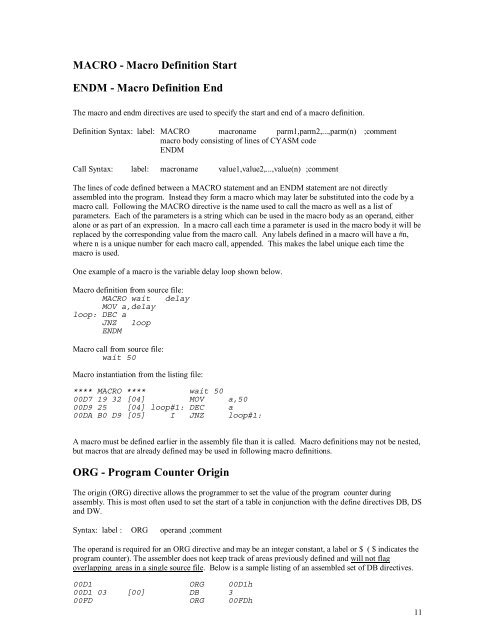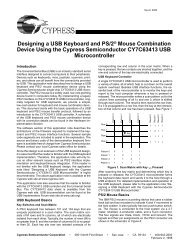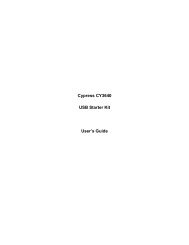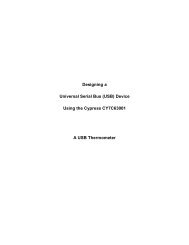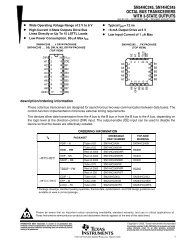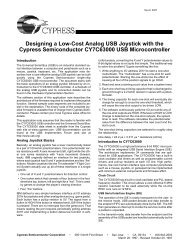CYASM ASSEMBLER USER'S GUIDE VERSION 1.77
CYASM ASSEMBLER USER'S GUIDE VERSION 1.77
CYASM ASSEMBLER USER'S GUIDE VERSION 1.77
Create successful ePaper yourself
Turn your PDF publications into a flip-book with our unique Google optimized e-Paper software.
MACRO - Macro Definition Start<br />
ENDM - Macro Definition End<br />
The macro and endm directives are used to specify the start and end of a macro definition.<br />
Definition Syntax: label: MACRO macroname parm1,parm2,...,parm(n) ;comment<br />
macro body consisting of lines of <strong>CYASM</strong> code<br />
ENDM<br />
Call Syntax: label: macroname value1,value2,...,value(n) ;comment<br />
The lines of code defined between a MACRO statement and an ENDM statement are not directly<br />
assembled into the program. Instead they form a macro which may later be substituted into the code by a<br />
macro call. Following the MACRO directive is the name used to call the macro as well as a list of<br />
parameters. Each of the parameters is a string which can be used in the macro body as an operand, either<br />
alone or as part of an expression. In a macro call each time a parameter is used in the macro body it will be<br />
replaced by the corresponding value from the macro call. Any labels defined in a macro will have a #n,<br />
where n is a unique number for each macro call, appended. This makes the label unique each time the<br />
macro is used.<br />
One example of a macro is the variable delay loop shown below.<br />
Macro definition from source file:<br />
MACRO wait delay<br />
MOV a,delay<br />
loop: DEC a<br />
JNZ loop<br />
ENDM<br />
Macro call from source file:<br />
wait 50<br />
Macro instantiation from the listing file:<br />
**** MACRO **** wait 50<br />
00D7 19 32 [04] MOV a,50<br />
00D9 25 [04] loop#1: DEC<br />
00DA B0 D9 [05] I JNZ<br />
a<br />
loop#1:<br />
A macro must be defined earlier in the assembly file than it is called. Macro definitions may not be nested,<br />
but macros that are already defined may be used in following macro definitions.<br />
ORG - Program Counter Origin<br />
The origin (ORG) directive allows the programmer to set the value of the program counter during<br />
assembly. This is most often used to set the start of a table in conjunction with the define directives DB, DS<br />
and DW.<br />
Syntax: label : ORG operand ;comment<br />
The operand is required for an ORG directive and may be an integer constant, a label or $ ( $ indicates the<br />
program counter). The assembler does not keep track of areas previously defined and will not flag<br />
overlapping areas in a single source file. Below is a sample listing of an assembled set of DB directives.<br />
00D1 ORG 00D1h<br />
00D1 03 [00] DB 3<br />
00FD ORG 00FDh<br />
11


